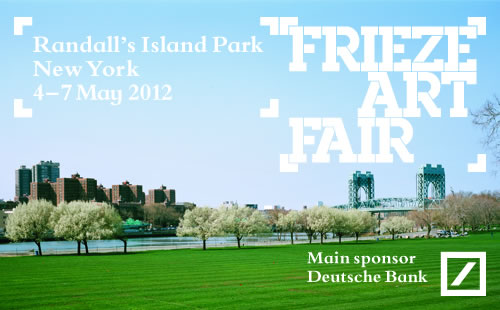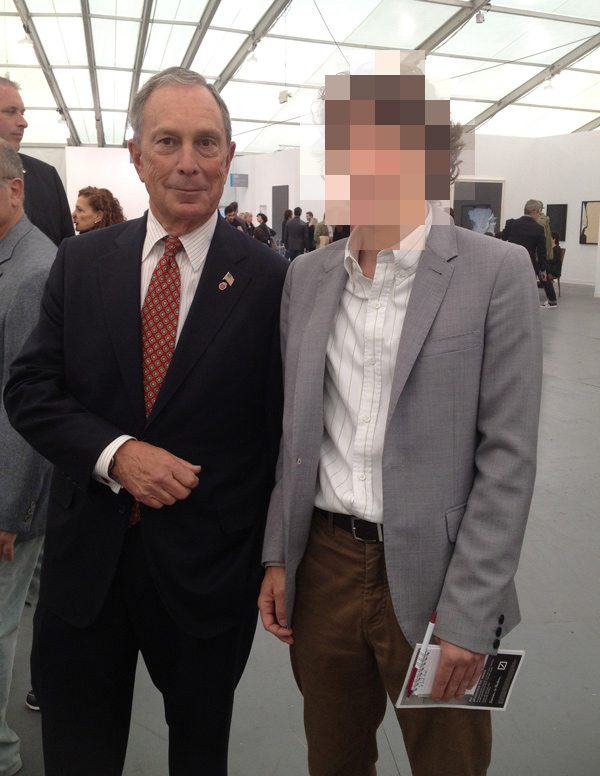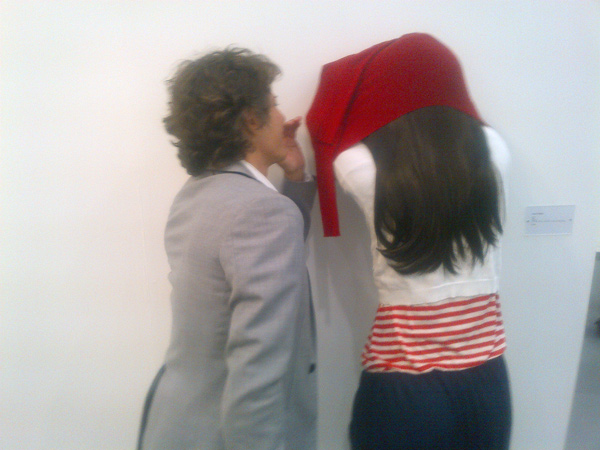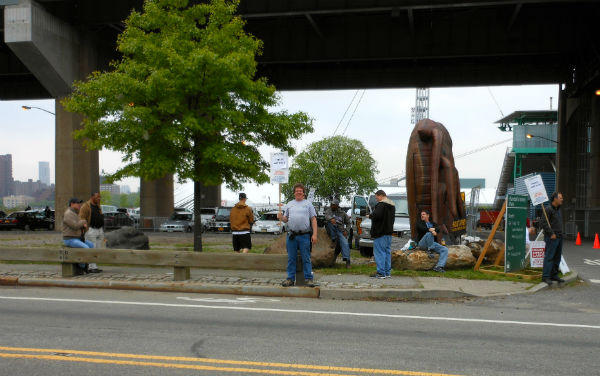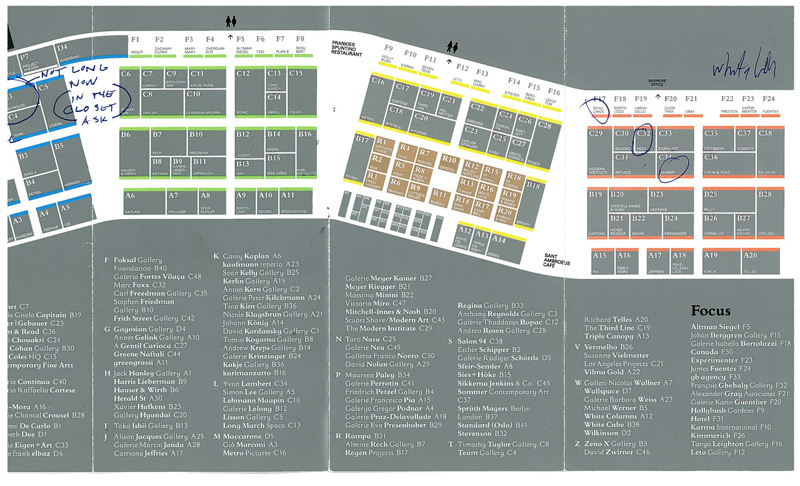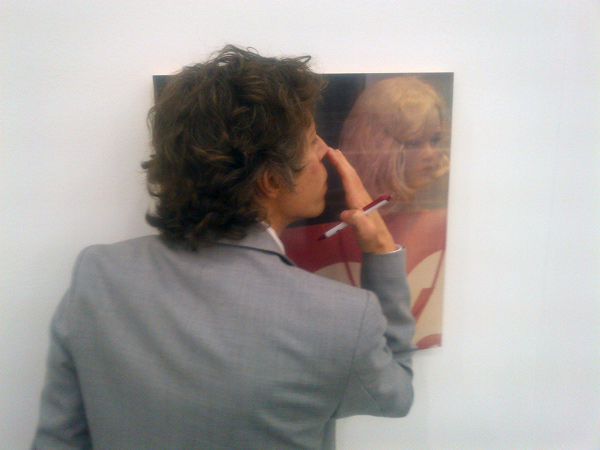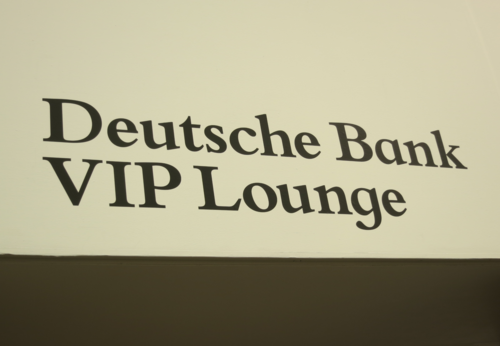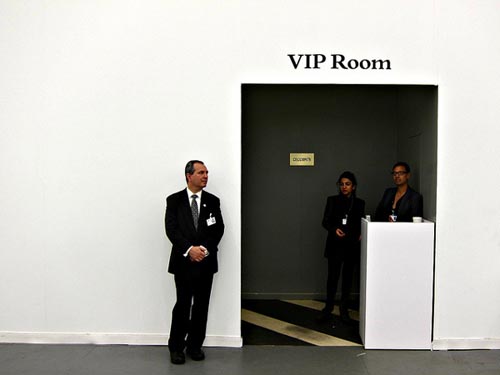Wake Me When It’s Over.
A critic at Frieze New York, on Ambien.
The fair opened at two. Now it was three, time for a fashionably late arrival. A car service rolled us up to the vaporetto launch for twenty bucks. Ferries waited near an active helicopter pad. The ships were forty feet long, three decks and open-air seating on the roof, pristine white with blue lettering spelling out aquatically themed names like “Seafoam,” “Seabreeze,” etc. Frieze was pulling out all the stops; as nominal VIPs we could’ve taken chauffeured BMWs to Randall’s Island, complete with audio “artist projects”; or if we preferred, apparently, yachts. It was a shock and awe campaign aimed at the Midwestern firm that had bought the Armory Show several years ago and driven it into the dirt with their trade-show mentality. Give them the Regent’s Park treatment and they would throw down their guns and run screaming all the way back to Illinois.
We had to wait ten minutes and spent the time wondering if any of the helicopters were heading to Roosevelt Island and if so who was in them. Dasha Zhukova? Francois Pinault? The best plan I have for killing myself involves taking a helicopter tour of an impossibly beautiful place, Kaui’i say, and ODing as we graze the canopies of rainforests and limn waterfalls. The choice of music would be important. It wouldn’t be very fair to the pilot, but killing oneself is notoriously unfair to the people you leave behind.
The attendant who’d been blocking our way, clipboard to breast, suddenly let us all pass—but she pointed off to the left, mysteriously away from the yachts. We went around the corner and there was our boat, a dumpy little water taxi bobbing out of sight at the end of the dock. It was painted a kitschy yellow, like a real cab. Truth be told those of us going to the two o’clock opening were only second class at best; the real VIPs had entered at eleven and would have mostly gone by the time we arrived. Our boat did have a bar though, similar to the one on the Staten Island Ferry, and there were nice, colorfully upholstered seats, like on an overnight bus in Europe. An Irish coffee for six bucks washing down half a blue Ambien controlled-release 12.5 mg tablet: we were off.
By the time we had finished getting drinks all the chairs were taken except the jump seats, pull-downs that faced everyone else. I found myself across from my friend J., a hot and possibly brilliant art historian. We talked nonstop for the whole 20 minutes of the trip. She’s manic, practically speaking if not clinically, and I have wanted to sleep with her since we were seated side by side at a dinner party several years ago. In a strange and coincidental turn of events I soon found myself talking to her about R. Kelly. It had to do with Liam Gillick, unfortunately. He is one of those people who when you bitch about them you know you are letting them win—rather like art fairs, actually; rather like capitalism. There was a piece by him in the new Afterall on Trapped in the Closet, which is of course Kelly’s much-wondered-at song/video cycle from the years 2005–07 (a man does have to stay up on the culture). It was a typically ruining-it-for-all-of-us exercise, the way that his writing on Swedish auto-worker factory seizures ruined Marxism, the way that the first show I ever saw by him, related to Walden Two, made me, a psychology major and armchair shrink, think, God, I never want to read that book.
(Gillick famously found it necessary to dispute in print not just certain facts about but also the interpretation of his work propounded in an essay by Claire Bishop in October a few years ago, every exquisite phrase of his correction worthy of lathing into powder-coated aluminum. No, seriously, he writes well; the R. Kelly piece was kind of good. We will see if he reads Dis I guess. I only half fact-checked the above, to give him something to prime the pump.)
At first J. had thought I’d said Mike Kelley, given recent events. R. Kelly? No idea. I gallantly offered to make her a mix. Then on the pretext of inquiring about her health—she’d had surgery two weeks ago—I insisted at taking a look at a fresh scar of hers. I may even have extended a finger toward it. There is a real exhilaration when drugs or a well-scripted social experience kicks in, like a barometric dip.
I can be forgetful in the best of circumstances. We all can. If there weren’t an oven timer, would my frozen pizza burn? If I didn’t have an alarm, would I wake up in the morning? If there weren’t a timer on the treadmill at the gym, would I ever stop running?
*
We debarked. Lingering with J. I fell behind my two companions, a dealer visiting from Mexico and a local artist he shows. I passed some pretty green swards and outdoor sculptures, meeting them on a short crest at the big tent.
Did you see the mayor? the artist said. I had not. What? He was incredulous. Bloomberg had gone in right in front of us; a security man had shouldered him out of the way. And sure enough, when we went inside and passed the ticket window—a flash of a VIP card—there he was, he and his entourage zipping out of view into the maze of booths.
The richest man in New York, the artist said solemnly. I liked the sound of that. Was it true? Close enough. He was short and had a little something wrong with his walk, a bit of a limp or hunch.
We lurched to a stop barely out of the doorway. Something looked amazing. This was the opinion of the artist, named Rod, and after my eyes focused it became mine also. Seven or eight gorgeously soft subtle abstract paintings spread their arms, welcoming you to the inaugural edition of Frieze New York. It took me a long moment to find the placard, which indicated it was the booth of a gallery from L.A. whose name I knew well, and another moment to understand why: the paintings were by a friend of ours. Visual agnosia, the problem is called. As a psychology major I had classes in perception and cognition both.
On my last trip to L.A. I had barely seen our mutual friend; he was busy in the studio. When we did meet up one afternoon he confessed that it felt weird being an emerging artist in his forties; by “weird” he no doubt meant certainly better than it might have been but also precarious. He was telling me he couldn’t afford to fuck it up.
And now here he was at the entrance to an art fair with these Rothko-y things. A week later at auction a Rothko sold for $86.9 million, a new record for a postwar work. Rod took a photo to show him how great the booth looked and when he sent it, I told him to tell him I said hi.
*
As we traversed the floor plan we fell quickly into the social routine intuitive to these sorts of events. The members of your group remain in loose proximity and loose communication as the art rolls by and people you haven’t seen for months or years pop up like zombies in a horror movie. You keep up the appearance that you’re all part of each other’s entourage and try not to ditch for as long as possible. Premature desertion is a real faux pas.
We emerged into a clearing; the fair’s “bespoke architecture” furnished an indefinite number of them. For these and other features—airy volumes, easy traffic flow—the enormous tent was universally praised. It had been designed by a Brooklyn-based firm called SO-IL, a name that should have felt self-deprecating but did not, and had ended up being worthy of the Guinness Book of World Records, built by scabs to boot. OK, not scabs technically, but nonunion labor. We were supposed to object. The New York City & Vicinity District Council of Carpenters would be protesting all weekend, along with an Occupy Wall Street group. These tidbits of consciousness raising circulated, as if the knowing would absolve us for not giving a shit, for crossing a picket, for not picketing ourselves. An inflatable union rat had been earmarked for the entrance, I had read about it but hadn’t seen it. It was possible though I had been oblivious or else gone in the wrong door.
We came to the first of the gourmet restaurants there had been so much buzz about. This was the Fat Radish. I am pretty sure it was the Fat Radish, anyway, because I had always secretly wanted to try the place despite the idiotic dick joke of its name. In the non-Frieze universe it was located around the corner from my girlfriend’s gallery, so I passed it a lot, and it always looked enticing in a way. The food was more or less the same as those lugubrious indie-rock haute locavore places with antlers over the fake fireplace but purged of all that kitsch in favor of classic Hamptons rustique. It was just another kitsch but one honest about its aspirations, which I preferred. Plus I always found upstate depressing and liked the beach.
Rod went with me to the bar. I ordered us a cappuccino and a Fernet. He insisted on ordering his dealer, now absent, a coffee, and graciously paid. We had been ditched but there were professional considerations: it had been a while since Rod had had a show in Mexico City. It is nice to have a drink waiting for you, even if it’s gone cold.
*
Professional considerations. They’re worth going into. The night after the opening the person I was seated next to at dinner told me that he found the element of self-sabotage the most interesting part of my “project,” as he termed it. Which was, now that you mention it, exactly what?
My project was to attend the opening of an event that somehow had come to loom on the art world’s calendar as large as Christmas and turn myself into an obstacle—present but inert, wasting people’s time in pointless and incoherent conversations, disconcerting art dealers by riffling their press materials, image binders, and stacks of catalogues, all with the help of a popular sleep medication—one of the age’s two iconic drugs to my mind. (The other is Adderall, which I had used for the past couple fairs.) It was a tiny gesture against the perpetual-motion gears of stimulus and response that crank our cultural and consumer habitus and, increasingly, the practice of criticism itself. Was it enough to stand aside? No, better to stand around, get in the way. I would wedge myself in a critical conduit and render it inoperable: I would convince someone to commission me to cover Frieze and write something useless, bringing the flow of cultural capital to a halt.
And if a halt was too ambitious, well, I could at least slow things down. Real slow.
*
I had wandered into the show’s Frame section, a collection of solo presentations of youngish artists by new galleries in a “curated” forum. I’m not sure how I got there, or how I knew it was the Frame section, since I was having trouble matching the map to the 4-D world;
probably it was via my ex-roommate J., who shadowed me for a while for laughs, or out of pity. After leaving the restaurant I had taken another half an Ambien and soon it became as if my optic nerves had been shot full of Novocain—the eyes let in light and made pictures but they failed to engage the processing mechanism when it came to language or semiosis of any sort. Nor did the haze allow for any kind of holistic awareness, any of that animal observation of people’s tells; the Ambien blunted my ability to pick up all those little twitches and inflections that make up what we call “mood.” I was locked inside my own little brain-box more than ever, alone with whomever I happened to be talking to or staring dumbly at. Thus I am unable to fulfill one of the functions of a piece of writing like this, which is to say what was “going on,” what it “was like.” People did seem to be enjoying themselves, and the gallerists didn’t seem to be working too hard. But then it behooved them to look as if everything was already sold.
I went to check out an installation by an acquaintance from L.A. She had turned the booth into an oversized gloomy shadowbox—you couldn’t walk into it; in fact you could barely look at it without tumbling into a visual and emotional abyss. It was dense, dark, enveloping, in keeping with a certain strategy for art fairs in which, for publicity, you set up something you could never possibly sell. There were foliage and various other materials I think in a symmetrical ascending layout plus mirrors and video elements and textual LED streams—Indiana Jones meets Nam June Paik meets Jenny Holzer. These details are almost certainly inaccurate, remember.
I said hi to the gallerist, whom I had bad blood with. No doubt she could tell that I was angry at her, because our conversation was brief and awkward and she turned away to talk to a collector or somebody as quickly as possible. Before doing so, however, she handed me an 8 ½ x 11 office laser print titled “Insanity Script” that went with the installation, supposedly. Items included:
—Do you enjoy inflicting physical damage on yourself?
—Are you purposely lying to conceal your mental instability or stability?
—Do you draw pictures of people being violently injured?
—Have you ever tried to fly? Did you die as a result?
The artist walked up. Like Michael Bloomberg she is also short, 5’ 1” on a good day and super cute in my opinion. For the record I am 5’ 6”. People in the art world tend to be smaller, I think.
Before leaving Frame I had to find my girlfriend’s work. Luckily you couldn’t miss the booth: her gallery had gotten a plum placement on a corner. The display had a wide-open look, stark in the way it sconced six or seven assaultive, almost garish artworks. I started examining them from left to right and immediately became lost in the first piece’s intricacy—blinded even. I blinked off the rest like retinal afterimages.
When I opened my eyes the gallery’s director was walking up. We talked for a while. He appeared happy and alert, all spectacles and tie clip. Sometimes he seems too decent to run a gallery. The Mexican dealer I had come to the fair with had complained to me about being called “winsome” in a recent online gossip piece (he pronounced it “wine-some” but neither I nor the artist in his stable corrected him). When he had looked it up he found that it meant “innocent,” technically, which I thought was kind of sweet. He felt to the contrary, however. Of course his complaining was just another kind of bragging: he was grousing so everyone would know the writer was flirting with him in print. But at the same time he had a point. Being an art dealer is like being a gangster: you want people to think you’re an asshole.
As for the girlfriend, she was either floating around near the booth or we called or texted; in either case we met up. She had asked me to leave her out of my Frieze piece, which I totally understood. Professional considerations. I am told that I ran into her best friend D. at some point also, and if so it’s likely to have happened here, with a kiss on the cheek.
All that kissing. The week after Frieze there were a lot of people sick.
*
Rod appeared, the last good man. He took me to the bathroom. There is a lot of talk of American exceptionalism these days but this bathroom was truly exceptional, a modular rental unit that you might masturbate sadly in at the lavish wedding of your ex-girlfriend on her family’s lakeside property on a perfect late spring evening. Unfortunately I can provide no details of its finish or accoutrements. I took another half an Ambien; 18.75 mg, a lot but nothing heroic, even when combined with three or four drinks.
When we emerged we ran into my friend A. He’s someone I love seeing art with, but it was too late for that: closing time had broached the horizon like a black sun. Time for one more drink though, to fortify us for the long walk back to the launch. We strode up to the VIP lounge, which had a Deutsche Bank logo over the door, and were summarily turned away, lacking the right passes: we were, of course, in a world with multiply credentialed echelons of VIP. The lounge for our kind was next door, unmarked. A lack of a logo had never before struck me as déclassé.
Inside it was loud and shit was everywhere, plastic water bottles, dirty napkins, rolled-up discarded maps and other fair paraphernalia, empty cups with gnawed brown stirrers bent over the rims. At the bar drinks were not complementary; Carlos Slim was no doubt sipping freebies in the Deutsche Bank ultralounge but here you had to pay. A. was ready to forget it but out of spite—masochism—I insisted on waiting in a scrum to buy us a couple of sixteen-dollar flutes of champagne with my Capital One card. Two underpaid and undertipped people in rental bowties ran unhappy dashes behind the bar trying to keep up with the customers. It was taking a while. There was a cocktail menu but my eyes wouldn’t focus at all at short range. The bartenders were playing goalie in a game we could all only lose. As the last of my tranquility simmered off, I turned to A. and said, Fuck it, let’s go.
Except that it wasn’t A., it was my friend N. Like him she is wise, kind, and a curator, but they are pretty different in most other respects. I was not sure when they switched or even if it was her I had been with all along. Rod had disappeared at some point in here too, I realized. Possibly midsentence I walked off and was immediately alone.
Then after a gap of seconds or half an hour I had landed with my friend M., an artist, who wrapped her arm around my leg. She was seated and had arrested me as I’d walked past her—I was noticing a lot of people and ignoring them, apparently. We had a moderately sexualized relationship ever since we made out a few years ago at a Christmas party. She was wearing something backless, leather it seemed and maybe made out of an old couch: like her work the garment displayed an impressive handling of materials. As her arm seemed to have boaed itself around my thigh so my hand felt free to drift down her back across a limitless expanse of skin. She was cool, refreshing. Ambien is a great drug for sex if you can remember to use protection.
*
People were leaving. There was a scurrying-for-the-lifeboats feeling. My wits were coming back. I found myself alone surrounded by people on their cel phones, all going places and making plans.
I pulled out my phone and called my friend David, a lawyer. Though the financial realities of having two young children have caused him to take on a variety of freelance assignments, he spends the bulk of his time working to ensure that prisoners are accorded all their legal rights, guilt or innocence be damned. I frequently encourage him to bring his razorlike logic to bear on the absurdities of the art world and of my life.
So many people have looked at me in quiet horror when I’ve told them about going to Frieze on Ambien that despite having explained once already, above, I will in closing reproduce the apologia I left on David’s voice mail when he failed to pick up.
True, the market vests less power in critics than it once did. And yet it desires legitimation seemingly separate from itself, so that the abstraction of money can claim access to “the real.” Expert opinion is required, since in the realm of the aesthetic what is real or true is a tenuous thing.
But opinions are like assholes, as the adage goes—everybody’s got one. And it’s not your grandfather’s asshole we’re talking about here. Today’s bung is perpetually massaged, in constant dialogue with the smooth rod of consumer capitalism reaming it in and out, over and over, to infinity. The annular ring modulates per cybernetic loop: a tenderly calibrated response reciprocates the slightest stimulus. We are continuously palpated, examined, and conditioned by that examination to crave more of it in a constant, low-level-erotic give and take. No proposition passes without meaningless contestation, no web page is complete without a moot Comments field. And all of it rouses a meaningless tingle in the groin.
The interpellation of critics by something like Frieze is akin to our general interpellation into a set of false choices, designer skins on the same piece of tasteless fruit. To choose not to respond—that might be a choice. But if you don’t speak, how will anyone know why you’re keeping quiet?
Frieze New York. Would you care to take a brief survey about your experience? No, I would not.
